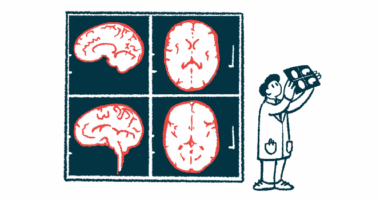When your body’s defenses go to war with your hair
Uncovering one possible consequence of an immune system disorder

Sometimes I stand in the shower, and time just slips by. I numbly run my fingers through my thick hair, and I’m immediately brought back to reality by the chunk of hair in my hand.
Hair loss can be a side effect of several medications, including prednisone, Solu-Medrol (methylprednisolone), and sometimes even gabapentin. As if living with neuromyelitis optica spectrum disorder (NMOSD) isn’t enough, I’m now dealing with side effects that make my invisible disability much more visible.
The hair-growth cycle consists of three phases: anagen (growth), catagen (transitional), and telogen (resting and shedding), though some authorities point to four stages, dividing the resting and shedding into telogen and exogen. Medications and autoimmune conditions can prematurely push hair into the telogen phases, leading to hair shedding, known as telogen effluvium. Autoimmune diseases that directly attack hair follicles can lead to more localized hair-loss patterns, such as patchy bald spots.
At first, losing hair didn’t seem like a big deal because I have so much of it, but now I feel it starting to thin, and my scalp feels a bit sensitive when I brush my hair. Hair is such an important part of our identity because how we style it, color it, and cut it is so fluid. Now I’m having to think about styling my hair in a way that doesn’t hurt and hides some of the thinning parts. That makes me angry. Hair loss is just another challenge that comes with being sick, and I’m not here for it.
The many possible causes
Certain NMOSD treatments aren’t supposed to cause hair loss, but it can occur. Immunosuppressant medications, for instance, affect rapidly dividing cells, which can include hair follicles. Some biologics — including the one I take, Uplizna (inebilizumab-cdon) — shouldn’t cause hair loss, though others can.
But when my immune system is affected, it stands to reason that my hair follicles may be affected as well.
Why? There are many possible reasons. For one, corticosteroids, which manage inflammation in autoimmune diseases, can affect hormonal balance. That can disrupt the hair-growth cycle and lead to thinning or losing hair. I’ve been on the corticosteroids prednisone and Solu-Medrol all summer long, so I’m not surprised that I’m still dealing with their side effects.
Stress can also exacerbate NMOSD, and that same stress can contribute to telogen effluvium. Now I feel like I’m stuck in an endless hair-loss stress cycle.
It’s also true that a diagnosis of one autoimmune disorder means the patient could be diagnosed with another at some point. In fact, that’s common. My team of neurologists have felt that I have lupus in addition to NMOSD, but recently their conversation suggests that I have vasculitis instead of lupus. It’s challenging to diagnose this second autoimmune disorder because my NMOSD medications might mask the biomarkers necessary to recognize what it is.
Lupus can cause hair loss because of scalp inflammation or because of the medications used to treat it and other skin conditions. Hair may become thin, break easily, or fall out in patches. And in discoid lupus, permanent scarring can cause irreversible hair loss.
Vasculitis, meanwhile, is a group of disorders characterized by inflammation of blood vessels, which can affect various organs and tissues, including the skin and scalp. Hair loss can occur in people with vasculitis through several mechanisms, including impaired blood flow to hair follicles.
Now I’m worrying about how much hair I’m losing. I even purchased a bottle of organic hair therapy shampoo that’s supposed to support hair growth and strengthen existing hair, but so far it just smells nice.
How I’m managing my hair loss
My first line of defense is to stay calm. Yes, I bought new shampoo, but it wasn’t a costly investment. Next, I’m having conversations with my medical team, including my neurologists, nurses, and nutritionist.
I’m told that a balanced diet rich in vitamins (especially iron, vitamin D, and biotin) supports healthy hair growth and may help mitigate the hair loss associated with autoimmune disorders. Rather than make my diet stressful, I’m focused on trying new recipes, spending time cooking for my family, and incorporating ingredients that support my health goals.
I could try other solutions, such as topical creams or more frequent haircuts, to promote natural growth, but I’m not there yet. Instead, I’m going to be grateful not only that I’m still here despite NMOSD, but also because I can always throw on a baseball cap and move on with life.
Note: Neuromyelitis News is strictly a news and information website about the disease. It does not provide medical advice, diagnosis, or treatment. This content is not intended to be a substitute for professional medical advice, diagnosis, or treatment. Always seek the advice of your physician or other qualified health providers with any questions you may have regarding a medical condition. Never disregard professional medical advice or delay in seeking it because of something you have read on this website. The opinions expressed in this column are not those of Neuromyelitis News or its parent company, Bionews, and are intended to spark discussion about issues pertaining to neuromyelitis optica spectrum disorder.







Leave a comment
Fill in the required fields to post. Your email address will not be published.